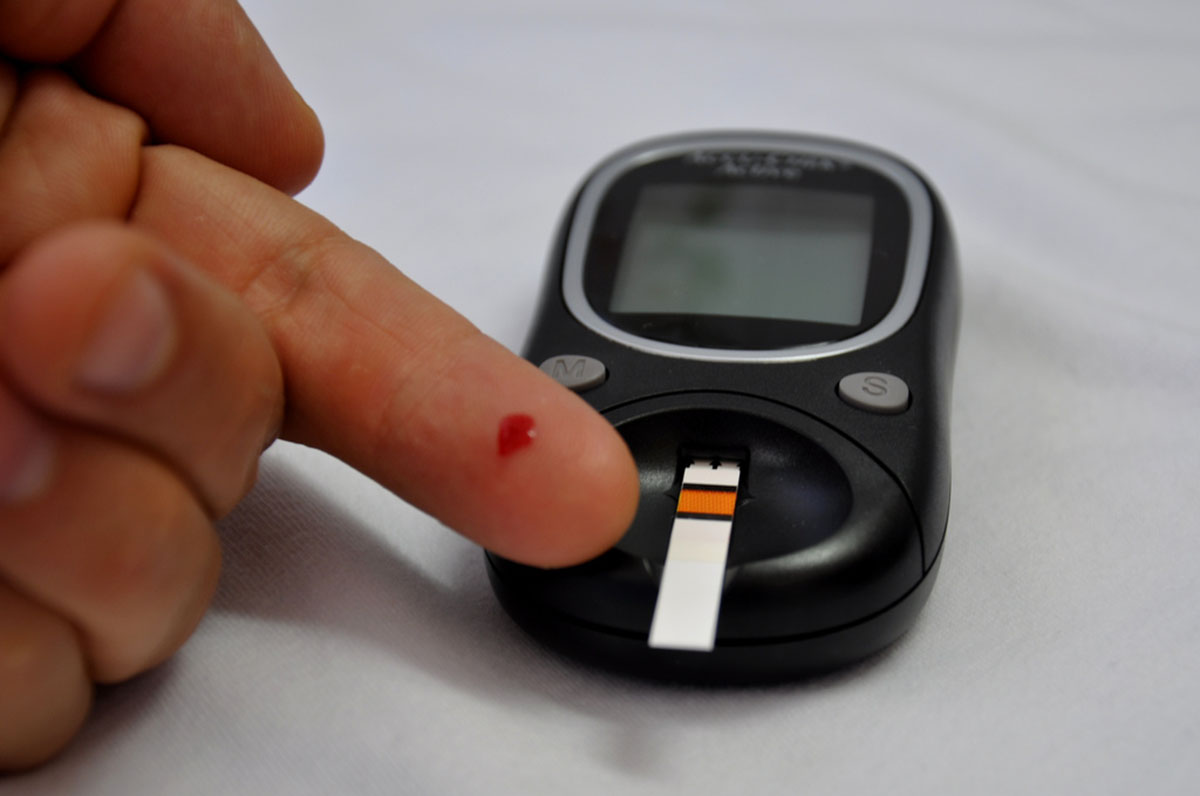Here's an important question for diabetics. When you use insulin or insulin-stimulating drugs to get your blood sugar levels down, do you know where the blood sugar goes? Much of it gets stored as fat in your liver, and eventually fatty liver can cause its own health problems.
Medical researchers have come to realize that about one out of every four people in the entire world has nonalcoholic hepatosteatosis, also known as NASH, the accumulation of fat deposits in the liver that is not triggered by alcoholism. One of the liver's major contributions to the body's overall functions is energy storage. Your body keeps the equivalent of about 1000 to 2000 calories of ready energy in the form of glycogen. The liver combines glucose with water to make glycogen, and when the body needs energy and you can't eat, it turns the glycogen back into glucose with the release of water. Your muscles do the same thing. Without this storage mechanism, we would have to eat 24 hours a day. People who suffer a defect of this storage mechanism can literally die if they do not get to eat in the middle of the night.

There are limits to how much energy your liver can store as glycogen. After the liver sets aside an emergency store of ready energy, it turns sugars into fatty acids and fatty acids into triglycerides. In a way, the liver is acting as a fire extinguisher. Too much glucose in the bloodstream can interact with metals (copper, for instance) and become a kind of sticky "caramel" that coats red blood cells and neurons. If you are a diabetic, you probably get regular tests for this; it's called glycosylated hemoglobin. To keep this caramel from gunking up cells all over your body, your liver turns sugar into fatty acids and fatty acids into fat. However, not all fatty acids are equal. Here's the problem:
- When your liver senses that your body isn't making (or, if you are a diabetic, you aren't injecting) a lot of insulin, it breaks down stored triglycerides into droplets of fatty acids that can escape through pores in the membranes of the cells that stored them. This gives your muscles a second source of energy when sugars run low.
- When your liver senses a high level of insulin in your bloodstream, it locks triglycerides in place so your bloodstream won't be flooded with potentially "combustible" substances. it cannot break down these stored fats into droplets that are small enough to escape your cells.
Of course, the same thing happens with your body fat. The explanation of fatty liver causes is a little long, but here is the common problem in both obesity and fatty liver disease.
- Fighting famine is the reason your liver cells and your body fat cells are programmed to hang on to triglycerides until the body absolutely, positively has to use them for energy. Fat cells and liver cells won't give up their fatty acids if they get hormonal signals that the body actually has more energy than it needs. In fact, the triglycerides inside fat cells are so bulky that they can't pass across the cell membrane to get back into the bloodstream to circulate to the muscles that would burn them.
- The signaling chemical for fat cells is insulin. As long as there are high levels of insulin (the hormone the body uses to transport sugar into cells for energy), fat cells are more responsive an enzyme called lipoprotein lipase, commonly abbreviated LPL. This hormone activates a series of processes that literally make them suck fatty acids out of the bloodstream for storage.
- At the same time LPL is changing the chemistry of fat cells so that they take fat out of the bloodstream and store it as triglycerides, insulin makes the muscles, which actually burn fat, less able to absorb fatty acids. LPL tells the body to burn sugar first. Fat cells don't actually respond to blood sugar levels (at least in this regard). They respond to blood insulin levels.
READ Fatty Liver: Treatment for Fat Accumulation in Liver Cells
- If your insulin levels are high, your body is poised to store every extra calorie as fat and your fat cells won't let fatty acids go. That is, unless something changes the balance of fatty acid storage and fatty acid release. Is all of this a little hard to follow? Here's the bottom line.
- Anything that increases your insulin levels, like eating sugary foods, keeps fat locked in your fat cells until you have gone long enough without eating that your body absolutely, positively has to use body fat for energy. The more sugar you eat, the longer the effect lasts. And if you are a diabetic who takes medications that increase your body's production of insulin or you inject large amounts of insulin, you naturally tend to get fatter and fatter. Your liver will get fattier and fattier, too.
Why should you care?
How Serious Is Fatty Liver Disease? Who Gets It? What Can You Do?
If the process of turning sugar into fat goes on long enough, liver cells start to become inflamed. The liver protects itself by isolating inflamed fat-filled cells through a process called fibrosis. These fibers can accumulate until the liver is in a state of cirrhosis. The liver becomes so "stringy" that oxygen from the bloodstream doesn't reach its innermost parts. The "centrilobular" liver ceases to function normally. It can still process nutrients, but it accomplishes this with pro-oxidants. These highly charged chemical entities damage the liver even more, causing even more fibrosis, leading to even worse cirrhosis.
At the same time, other parts of the body start storing the fats that can't be stored in the liver. Unfortunately, these fats tend to accumulate in the intima, or lining, of major arteries. The walls of arteries get thicker and thicker and thicker. This makes them stiffer and stiffer, less able to continue to conduct blood should you get a blood clot. Your risk of heart attack rises significantly when you develop fatty liver disease. Over a period of 10 to 12 years, fatty liver can elevate your risk of heart attack by about 300 percent. You will be acutely aware of the effects of fatty liver disease (there's essentially no such thing as fatty liver pain, for instance), but you may never have a hint of fatty liver symptoms.

Just how many people have fatty liver disease? A recent study found that one out of every four people on earth has the condition.
- The highest rates of fatty liver disease are in South America and the Middle East. These are also the parts of the world where it is least likely to be diagnosed and treated.
- The lowest rates of fatty liver disease occur where famine is still an issue, mostly in Africa.
- People who get fatty liver disease have about a 1-1/2 percent risk of developing liver cancer in any given year. That's about a one in two chance over a lifetime (after diagnosis) for most people who have the condition. That's many times higher than the risk for people who don't develop fatty liver disease.
- People who get fatty liver disease are at higher risk for heart attack and stroke, and less likely to survive heart attack and stroke when they occur.
People who have fatty liver disease almost always are people who are obese. It's not really accurate to say obesity "causes" fatty liver disease. The same factors are at work in both the liver and the fat mass. It is accurate to say that overeating sugars causes fatty liver disease. However, losing weight can reverse fatty liver disease, sometimes in just a few weeks. You can reduce the stress on your liver by:
- Losing body fat, not just weight. If you (like many South Asians) are of normal or low body weight but you have a fat tummy, you still need to lose more body fat.
- Losing body fat by lifestyle changes. To achieve a fatty liver diet you just need to eat less. It's not enough to just exercise more. Otherwise, you will never get control of the excess insulin that keeps fat locked in liver cells and fat cells.
- Losing at least 5 percent of your total weight. That's all it takes to reverse the process that gives you fatty liver. Losing 10 percent of your total weight will also have a beneficial effect on diabetes.
READ Omega-3 Fatty Acids And Their Effect On Brain Function
Fatty liver disease is almost never directly deadly. For this reason, it's often missed even by the most attentive doctors. Getting your weight down by eating less carbohydrate may save your liver and prolong your life.
- Chow WC, Tai ES, Lian SC, Tan CK, Sng I, Ng HS. Significant non-alcoholic fatty liver disease is found in non-diabetic, pre-obese Chinese in Singapore. Singapore Med J. 2007 Aug. 48(8):752-7. [Medline].
- Park JW, Jeong G, Kim SJ, Kim MK, Park SM. Predictors reflecting the pathological severity of non-alcoholic fatty liver disease: comprehensive study of clinical and immunohistochemical findings in younger Asian patients. J Gastroenterol Hepatol. 2007 Apr. 22(4):491-7.
- Photo courtesy of v1ctor: www.flickr.com/photos/v1ctor/10871254373/
- Photo courtesy of zuerichs-strassen: www.flickr.com/photos/zuerichs-strassen/17433505865/
- Photo courtesy of v1ctor: www.flickr.com/photos/v1ctor/10871254373/


Your thoughts on this